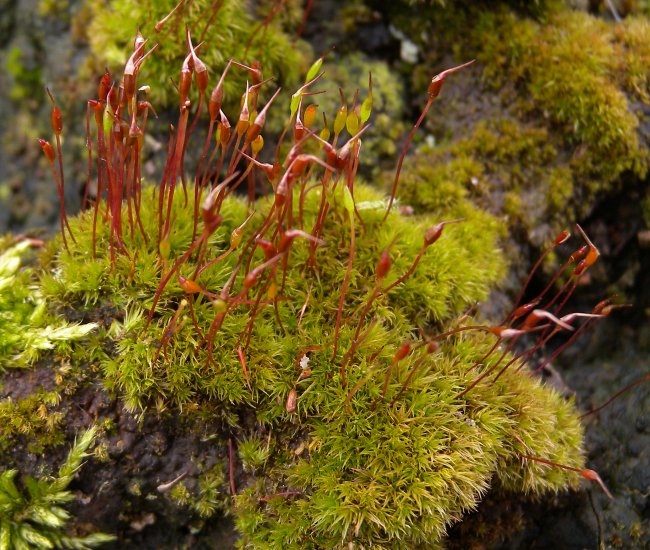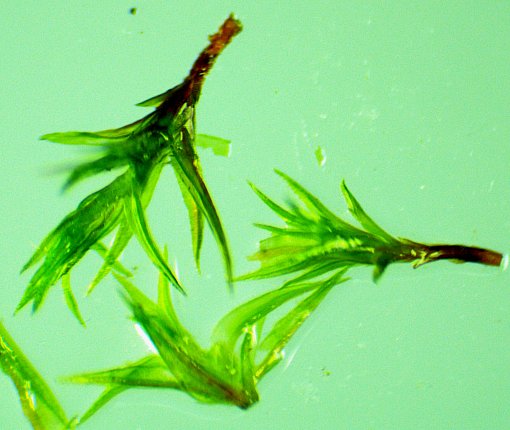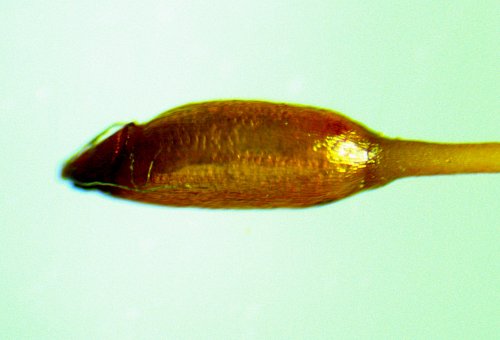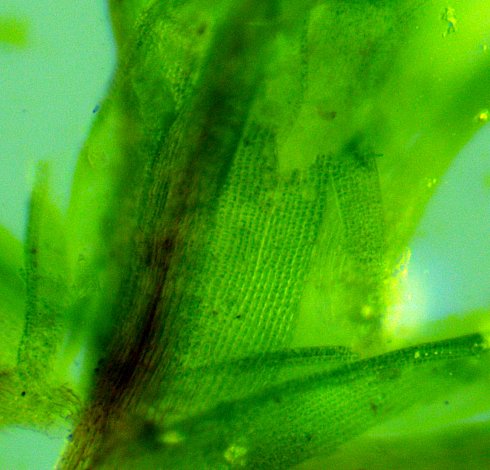
This moss is dioicious, forming male and female sexual organs on different plants. After fertilization occurs, fertile shoots terminate in solitary spore-bearing capsules on more or less erect stalks (setae). These stalks are 1-3 cm. long, slender, and terete; they vary in color from yellowish green to deep red. The spore-bearing capsules are 1.5–2 mm. long (excluding their hoods or calyptra), ellipsoid-cylindrical in shape, and they are held more or less erect on their stalks. Initially, these capsules (both their bodies and lids) are light green, but they soon become deep red or reddish purple. The lids (opercula) of these capsules are conical in shape. The upper bodies and lids of these capsules are initially covered with white-membranous hoods (calyptrae). These hoods are hairless and long-beaked; the beaks are usually held at angle. As the capsules age, they become brown, longitudinally furrowed, and curved; they are held more horizontally from their stalks. Eventually, the lids of the capsules fall off, revealing a ring of 16 teeth. At this time, the tiny spores are released to the wind. The root system consists of a mass of fibrous rhizoids.

Cultivation: The preference is full sun to light shade, moist to mesic conditions, and soil that contains sand, gravel, cinders, or clay. This moss tolerates air pollution and the presence of heavy metals in soil to a greater extent than most mosses. Like many other mosses, it prefers some protection from prevailing winds and a microhabitat with a higher-than-average humidity level.
Range & Habitat: The native Purple Moss is common in the northern half of Illinois, while in the southern half of the state it is occasional to rare (see Distribution Map). However, this moss is more common within the state than herbarium records indicate. Purple Moss is widely distributed, occurring on all continents, including Antarctica. In Illinois, the habitats of this moss are quite diverse; they include sand prairies, sand dunes, degraded gravel prairies, moist ground of sandy savannas and sandy woodlands, open meadows, moist ground in woodlands and woodland borders, mesic ground on wooded slopes and bluff tops, banks and bottoms of wooded ravines, rotting logs in wooded areas, bases of deciduous trees, clay banks and sandy banks along streams, moist rocks along streams, clay banks of roadside ditches, banks of prairie sloughs, sandstone outcrops and sandstone ledges, old fields, vacant lots, grassy lawns, cindery ground along railroads, ground areas along buildings, roof tops of buildings, exposed soil along sidewalks, ground adjacent to mine spoil piles, rocky or gravelly ground of quarries, crevices of old tombstones, and disturbed areas with exposed barren ground. Habitats with a history of disturbance are preferred. This moss can become more abundant in some habitats in response to wildfires and controlled burns.

Faunal Associations: Very little is known about floral-faunal relationships for this moss in North America. It has been used in the construction of nests by the Slate-colored Junco (Breil & Moyle, 1976).
Photographic Location: On ground soil in Busey Woods of Urbana, Illinois.

Comments: This is the only moss species of its genus in Illinois. In addition to Purple Moss, other common names of Ceratodon purpureus include Redshank and Fire Moss. This moss is attractive when its stalked spore capsules are deep red or purple. Across its wide distribution, it is somewhat variable in appearance as its leafy shoots can be somewhat variable in their size and color. When the spore capsules are absent, Purple Moss can be easily confused with other acrocarpous mosses with lanceolate or narrowly triangular leaves. It can be distinguished from some of these species by the prominent midribs of its leaves and its tightly folded leaf margins.